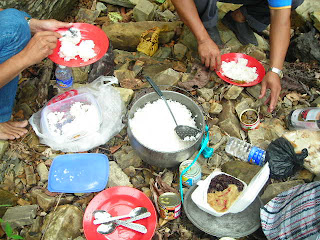
Traveling along dirt road is usually long and very tiring.

A little rest would be very refreshing..... especially near a water fall.

Even a simple meal could be very tasty.
The Buwau98 Chronicles

 These School Children are very motivated in collecting donations. Is there some sort of competition among them? As parents, how do you feel that when your children are seen in front of of gambling outlets asking for donation?
These School Children are very motivated in collecting donations. Is there some sort of competition among them? As parents, how do you feel that when your children are seen in front of of gambling outlets asking for donation?
 This is an early photo of the Lau King Howe Hospital of Sibu. Later it expanded to become a bigger hospital. But in the 80's the Sibu General Hospital was built in Oya Road and this hospital which saved many lives slowly disappeared into oblivion and disuse. Only a small part of the building is left to become a mini museum. A huge piece of the original land has been used up for urban development of Sibu.
This is an early photo of the Lau King Howe Hospital of Sibu. Later it expanded to become a bigger hospital. But in the 80's the Sibu General Hospital was built in Oya Road and this hospital which saved many lives slowly disappeared into oblivion and disuse. Only a small part of the building is left to become a mini museum. A huge piece of the original land has been used up for urban development of Sibu.



 Suman Pais is basically seafood mixed with sago flour and wrapped in Nipah leaf and cooked over a slow burning fire. Sounds so easy but actually not so.......
Suman Pais is basically seafood mixed with sago flour and wrapped in Nipah leaf and cooked over a slow burning fire. Sounds so easy but actually not so....... Days when you were young and carefree are part and parcel of the yester years that are etched deep in your mind. An old black and white pic like this sure worth a nostalgic thought, as your memories stroll along the lane of past events.
Days when you were young and carefree are part and parcel of the yester years that are etched deep in your mind. An old black and white pic like this sure worth a nostalgic thought, as your memories stroll along the lane of past events.

Horseshoe crabs possess five pairs of gills located just behind their appendages that allow them to breathe underwater, and can also allow them to breathe on land for short periods of time, provided the gills remain moist.
Although most arthropods have mandibles, the horseshoe crab is jawless. The mouth is located in the middle of the underside of the cepahalothorax with chelicerae located at each side of the mouth. In the female, the four large legs are all alike, and end in pincers. In the male, the first of the four large legs is modified, with a bulbous claw that serves to lock the male to the female while she deposits the eggs and he waits to fertilize them.
The Horseshoe Crab has blue blood, as it uses copper rather than iron as the base of its system.
Limulus has been extensively used in research into the physiology of vision. It has four compound eyes and each ommatidium feeds into a single nerve fibre. Furthermore the nerves are large and relatively accessible. This made it possible for electrophysiologists to record the nervous response to light stimulation easily, and to observe visual phenomena likelateral inhibition working at the cellular level. More recently, behavioral experiments have investigated the functions of visual perception in Limulus.
Limulus has two large compound eyes on the sides of its head, which have monochromatic vision. The individual ommatidia are complex, consisting of upwards of 300 cells; they number around a thousand, and are somewhat messily arranged, not falling into the ordered hexagonal pattern seen in more derived arthropods. An additional simple eye is positioned at the rear of each of these structures. In addition to these obvious structures, it also has two smaller ocelli situated in the middle-front of its carapace, which may superficially be mistaken for nostrils. A further simple eye is located beneath these, on the underside of the carapace. A further pair of simple eyes are positioned just in front of the mouth. The simple eyes are probably important during the embryonic or larval stages of the organism, and even unhatched embryos seem to be able to sense light levels from within their buried eggs. The less sensitive compound eyes, and the median ocelli, become the dominant sight organisms during adulthood.
The individual ommatidia of the compound eyes of Limulus Among other senses, they have a small sense organ which senses on the triangular area formed by the exoskeleton beneath the body near the ventral eyes.

|





My blog is worth $90990.99.
How much is your blog worth?